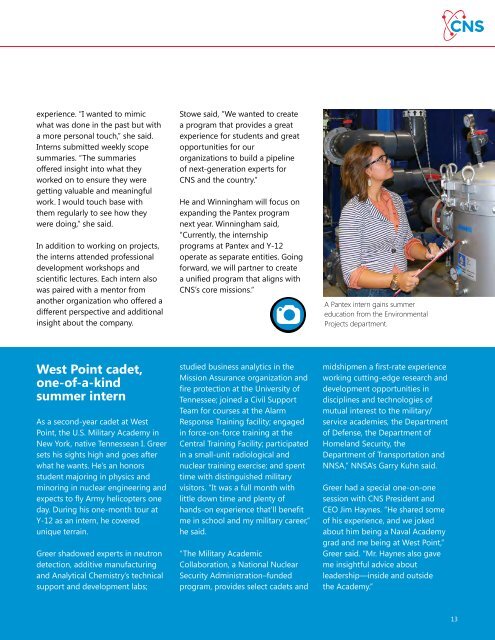THE STAR
The-Star-2015_Fall_web2
The-Star-2015_Fall_web2
You also want an ePaper? Increase the reach of your titles
YUMPU automatically turns print PDFs into web optimized ePapers that Google loves.
experience. “I wanted to mimic<br />
what was done in the past but with<br />
a more personal touch,” she said.<br />
Interns submitted weekly scope<br />
summaries. “The summaries<br />
offered insight into what they<br />
worked on to ensure they were<br />
getting valuable and meaningful<br />
work. I would touch base with<br />
them regularly to see how they<br />
were doing,” she said.<br />
In addition to working on projects,<br />
the interns attended professional<br />
development workshops and<br />
scientific lectures. Each intern also<br />
was paired with a mentor from<br />
another organization who offered a<br />
different perspective and additional<br />
insight about the company.<br />
Stowe said, “We wanted to create<br />
a program that provides a great<br />
experience for students and great<br />
opportunities for our<br />
organizations to build a pipeline<br />
of next-generation experts for<br />
CNS and the country.”<br />
He and Winningham will focus on<br />
expanding the Pantex program<br />
next year. Winningham said,<br />
“Currently, the internship<br />
programs at Pantex and Y-12<br />
operate as separate entities. Going<br />
forward, we will partner to create<br />
a unified program that aligns with<br />
CNS’s core missions.”<br />
A Pantex intern gains summer<br />
education from the Environmental<br />
Projects department.<br />
West Point cadet,<br />
one-of-a-kind<br />
summer intern<br />
As a second-year cadet at West<br />
Point, the U.S. Military Academy in<br />
New York, native Tennessean I. Greer<br />
sets his sights high and goes after<br />
what he wants. He’s an honors<br />
student majoring in physics and<br />
minoring in nuclear engineering and<br />
expects to fly Army helicopters one<br />
day. During his one-month tour at<br />
Y-12 as an intern, he covered<br />
unique terrain.<br />
Greer shadowed experts in neutron<br />
detection, additive manufacturing<br />
and Analytical Chemistry’s technical<br />
support and development labs;<br />
studied business analytics in the<br />
Mission Assurance organization and<br />
fire protection at the University of<br />
Tennessee; joined a Civil Support<br />
Team for courses at the Alarm<br />
Response Training facility; engaged<br />
in force-on-force training at the<br />
Central Training Facility; participated<br />
in a small-unit radiological and<br />
nuclear training exercise; and spent<br />
time with distinguished military<br />
visitors. “It was a full month with<br />
little down time and plenty of<br />
hands-on experience that’ll benefit<br />
me in school and my military career,”<br />
he said.<br />
“The Military Academic<br />
Collaboration, a National Nuclear<br />
Security Administration–funded<br />
program, provides select cadets and<br />
midshipmen a first-rate experience<br />
working cutting-edge research and<br />
development opportunities in<br />
disciplines and technologies of<br />
mutual interest to the military/<br />
service academies, the Department<br />
of Defense, the Department of<br />
Homeland Security, the<br />
Department of Transportation and<br />
NNSA,” NNSA’s Garry Kuhn said.<br />
Greer had a special one-on-one<br />
session with CNS President and<br />
CEO Jim Haynes. “He shared some<br />
of his experience, and we joked<br />
about him being a Naval Academy<br />
grad and me being at West Point,”<br />
Greer said. “Mr. Haynes also gave<br />
me insightful advice about<br />
leadership—inside and outside<br />
the Academy.”<br />
13


